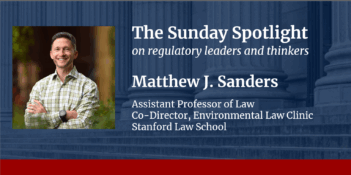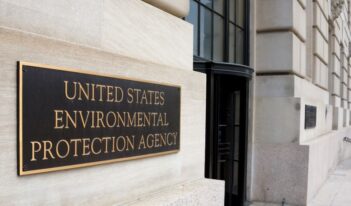
Scholars examine the history and consequences of the Clear Air Act’s exemption of existing industrial facilities.
For more than four decades, the Environmental Protection Agency (EPA) has worked to eliminate harmful air pollution pursuant to the Clean Air Act of 1970. And for just as long, EPA’s efforts have been hampered by a tragic flaw in that statute: its exemption of existing industrial facilities—most notably, coal-fired power plants—from federal limits on some of the most common, and harmful, types of pollution. As we explore in our new book, Struggling for Air: Power Plants and the “War on Coal”, this “grandfathering” of old plants has had grave and lasting consequences for public health.
Pairing restrictive standards for new sources with either lax standards or no standards at all for existing sources creates two problematic incentives: Old plants are encouraged to stay in business longer than they otherwise would, and new plants are discouraged from coming online altogether.
Imagine a utility that owns a single power plant. The plant has been in service for quite a while, and the utility is thinking about replacing it. For the utility’s purposes, the chief benefit of replacing the plant is the reduction in operational costs that will result from running a more efficient facility. All else being equal, newer plants typically wring more electricity out of a given amount of fuel.
The chief cost of replacing the old plant, meanwhile, is just that: the cost of building a new, more efficient facility. Thus, a rational utility should choose to replace the old plant whenever the amount it will save on operational costs over the life of the new plant outweighs the construction bill.
An environmental regulation that applies solely to new plants alters this calculus. Why is this the case? Let us assume that the only way to comply with the regulation is to install a new emission-reduction technology. Purchasing and installing that equipment, as well as operating it, will cost the utility money. So the costs of building a new plant have gone up, and the benefits—that is, the avoided operational expenses—have gone down, making the project less likely to pencil out for the utility. Academics call this distortion of retirement decisions the “old plant effect,” and the Clean Air Act is paradigmatic of the sort of policy that causes it.
Prior to the law’s passage, the economically useful life of a coal plant was thought to be about 30 years. But by 2012, more than three-quarters of the nation’s coal-fired generation capacity had been in service for longer than that. Indeed, as of that year, almost 40 percent of the nation’s coal-fired energy infrastructure was more than 40 years old, and close to 20 percent was more than 50 years old. Until quite recently, some operating plants dated all the way back to the 1940s, meaning that they had been running for more than twice their expected lifespan.
Grandfathering is not unique to the Clean Air Act, of course. On the contrary, exempting those already engaged in an activity from complying with new restrictions on that activity is common practice in a variety of legal arenas, ranging from the federal tax code to local licensing requirements for interior designers. Over the years, legal academics have identified three reasons—fairness, efficiency, and political pragmatism—that might justify offering some sort of “transition relief” to existing actors when imposing a new regulatory regime.
The classic rationale for transition relief is fairness. Proponents of this view argue that market actors rely on existing law when making investment decisions and, as a result, should be shielded from—or compensated for—legal changes that would decrease the value of those investments. By this logic, a power plant should not be punished for lacking pollution controls if no emission restrictions were in place at the time of its construction.
But is it truly reasonable for an investor to believe that the laws governing its investment will never change? Laws change quite often, after all—often in foreseeable ways. Furthermore, as critics of the “fairness” rationale have pointed out, society does not protect investors from market risks (like declining demand or technological change) that might affect the value of their investments. Why should regulatory risks be treated differently? Indeed, insulating investors from regulatory risks might distort their behavior in socially undesirable ways, leading them to overinvest in harmful but under-regulated activities.
Fairness aside, some appeal to a different rationale: that under the right circumstances, grandfathering is simply more efficient than treating new and existing sources alike. A rule is more efficient in the economic sense if it generates greater net benefits for society, with net benefits being the difference between the value of society’s gains from a regulation and the costs of complying with it.
Why might grandfathering be the more efficient choice? For one, compliance costs may be greater for an existing source than for a new source. Whereas a new power plant can be designed with scrubbers in mind, an existing plant might require expensive retrofits to accommodate new technology that its original architects had not anticipated. Thanks to these extra “transition costs,” a performance standard that is cost-benefit justified for a new source might not be net beneficial for an existing source.
But even where grandfathering looks more efficient in the short term, it may be undesirable in the long term. This is because the cost advantage of running an uncontrolled old plant rather than upgrading it or opening a new one will decline over time, as deteriorating equipment results in higher maintenance costs and as pollution-reduction equipment becomes more cost effective. As a result, the sort of indefinite grandfathering practiced by the Clean Air Act is particularly undesirable from an efficiency standpoint.
Finally, some defend grandfathering in terms of political pragmatism. This “public choice” justification for grandfathering posits that the practice is a necessary political evil that enables the passage of socially desirable legislation. Rather than subject all sources to additional regulation, a law that includes grandfathering concentrates the burden of compliance on sources that have yet to be constructed. That result may not please everyone in the industrial community, particularly younger, growing companies that plan to open a large number of new facilities in the future. Grandfathering will, though, appeal to mature players that have finished growing and are now more than happy to erect barriers to entry for potential competitors. With industrial opposition thus fractured, the legislation becomes easier to pass. And better a flawed law that includes grandfathering, the theory goes, than no law at all.
But in the environmental context, the notion of grandfathering as a political necessity is belied by the fact that Congress managed to avoid the practice in another major environmental statute passed not long after the Clean Air Act: the Clean Water Act of 1972. Like the Clean Air Act, the Clean Water Act imposed stringent federal standards on new industrial sources of pollution. But unlike the Clean Air Act, it also imposed federal standards on existing sources. Although less stringent than those imposed on new sources, these standards have been enormously successful, eliminating the vast majority of water pollution from so-called “point sources.” (Non-point pollution, like agricultural runoff, is another story.)
Those who advocate grandfathering on public choice grounds also overlook the fact that grandfathering is not a one-time legislative gift but an ongoing regulatory benefit. Once grandfathered, lobbyists for old plants do not simply pack their bags and go. Instead, they work to preserve and enhance their legally created advantage. In other words, lawmakers have not neutralized the opposition by engaging in grandfathering; they have just shifted the opposition’s harmful influence on policy to a later stage of decision-making.
In the end, we do not argue that the Clean Air Act in 1970 should have immediately subjected existing sources to the same standards as newly constructed facilities. But the transition relief it offered existing sources should have been much narrower.
For example, Congress could have adopted the Clean Water Act’s phased-in approach, which gave existing facilities five years to achieve compliance with a relatively lax standard and then another six years to meet a standard that was almost as strict as the standard applicable to new sources.
Alternatively, legislators could have fully grandfathered existing sources from federal emission standards, but for a limited time. Power plants, for example, could have been eligible for an exemption only until their 30th birthday—the end of their originally expected lifespan.
Instead, existing sources were given a near-complete, near-permanent exemption that enabled many to continue operating with minimal or no emissions controls for decades. And although this handicap did not prevent the Clean Air Act from achieving substantial improvements in air quality over the years, the law undoubtedly could have accomplished even more—even sooner— if old plants had been subjected to greater regulation.
This essay draws on Professor Revesz and Mr. Lienke’s recently published book, Struggling for Air: Power Plants and the “War on Coal.”





